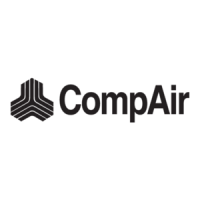69
With water-cooled combustion engines
with a closed cooling circuit, the cap of the
coolant recovery bottle must not be
removed before the system has cooled
down to ambient temperature.
Never fill up with fuel while the engine is
running. Make sure that fuel does not come
into contact with hot machine parts.
Do not smoke while filling up with fuel.
Filling up at a pump can cause static
electricity and possibly sparks. In order to
avoid this, a ground cable must be
connected to the system while it is being
filled up.
The exhaust emissions of combustion
engines contain carbon monoxide - a lethal
gas. If a machine with such an engine has
to work in an enclosed room, the exhaust
gases must therefore be conducted out
of doors by means of a hose or pipe with
an internal diameter of at least 100 mm.
The use of extraction systems is highly
recommended in test rooms for mobile
machines.
Before connecting or disconnecting
hoses, always close the compressor air
outlet valves. Before disconnecting a hose,
always make sure that it is not under
pressure.
A hose connected to an air valve must
be fitted with a safety wire for operating
pressures above 7 bars; it is in fact
recommended that this safety device
should be used for pressures above 4 bars.
The steel wire has a diameter of 8 mm
and is firmly clamped to the hose at least
every 500 mm. Both ends are fitted with
cable lugs.
Check the machine / installation for
external damage and faults at least once
per shift. Any changes noticed (including
changes in operating performance) must
be reported immediately to the authority or
person in charge. If necessary, shut down
and secure the machine immediately.
In case of malfunction, shut down and
secure the machine / installation
immediately. Have malfunctions corrected
immediately.
Observe the operating manual for start-
up and shutdown procedures as well as
inspection displays.
3.6 Special jobs / Maintenance
Care
Observe the setting, maintenance, and
inspection work and intervals stipulated in
the operating manual, including information
about the replacement of parts / partial
sections. This work may only be carried out
by specialists.
Maintenance work, tests and repairs
should be carried out in a well ventilated
room, away from heat, open flames, or
sparks. Appropriate prohibition signs (fire,
open flames, no smoking) must be put up.
Loss of oil leads to a very slippery floor.
Statistics have shown that many accidents
can be attributed to the installation or
maintenance of machines on oily floors or
machine components. For this reason,
always start maintenance work by cleaning
the floor and the machine exterior.
Inform operating personnel before
beginning to carry out special work or
maintenance. Nominate a supervisor.
After completing repair work, always
check to see whether any tools, loose
parts or cloths have been left in or on the
machine, driving engine or driving
equipment.
Maintenance and repair work is only to be
carried out under the supervision of or by a
person qualified for this work.
For all work concerning the operation,
production adjustment, conversion, or
settings of the machine / installation and its
safety-relevant equipment, as well as
servicing, maintenance, and repair,
observe the operating manual for startup
and shutdown procedures and the
instructions for maintenance work.
All maintenance and repair work may
only be carried out when the system is shut
down, or, with electrical systems, when the
mains power supply is switched off. Make
sure that the equipment cannot be
switched on by accident.
Whenever the machine/system is
completely powered down for maintenance
and repair procedures, it has to be
secured against unintentional power-on
or the mains supply has to be cut off
with electrical systems.
* Remove the ignition key, and / or
* Put up a warning sign on the main
switch “Attention! Maintenance work.”
Close off the complete maintenance
area, if required.
* Disconnect the starter battery.
Individual parts and larger subassemblies
must be carefully attached to the hoisting
gear and secured in case of replacement.
Only use suitable, technically perfect
hoisting gear and load suspension devices
with adequate carrying capacity. Keep clear
of suspended loads.
Before removing any part under pressure,
separate the aggregate effectively from
all sources of pressure and release the
pressure from the complete system.
Never use inflammable solvents or
carbon tetrachloride to clean parts.
Take precautions to avoid toxic vapors
from cleaning fluids.
Absolute cleanliness is essential during
maintenance and when carrying out
repairs.
Only carry out maintenance and repair
work when the machine is located on an
even, stable base and is secured against
running away and against buckling.
Only carry out inspection, maintenance,
and repair work when the screw
compressor system is at a standstill and is
not under pressure.
Protective devices, i. e. protective grids,
may not be removed during operation.
Caution while the screw compressor is in
operation.
After the work has been completed,
replace any protective devices that have
been removed. Operation without
protective devices is not permissible.
Working clothing should be close-fitting
during work on running screw compressor
systems.
Maintenance
During maintenance and repair work, the
contractor has to inform the personnel
about the dangers that can occur during
their work and about measures to avert
such dangers.
The personnel have to support all
measures to improve safety at work.
Safety devices for preventing or
eliminating dangers must be serviced
regularly and their functioning tested at
least once per year. Faults discovered must
be corrected at once or reported to the
supervisor.
Only use the correct tools for
maintenance and repair work.
Only use original spare parts.
All maintenance and repair work may
only be carried out when the system is shut
down, or, with electrical systems, when the
mains power supply is switched off. Make
sure that the aggregate cannot be switched
on by accident.
3. Security Regulations

